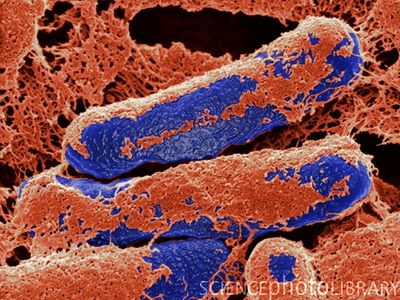Clostridium botulinum neu2011: Difference between revisions
| Line 22: | Line 22: | ||
==Description== | ==Description== | ||
<i>Clostridium botulinum</i> is a rod shaped, gram positive bacteria | <i>Clostridium botulinum</i> is a rod-shaped, gram positive bacteria that produces heat and chemical resistant endospores. The bacterium is a soil dwelling anaerobe that produces a known neurotoxin. The symptoms of botulism were first described by Justinus Kerner in the early 1820's. Kerner named the disease botulism after the Latin word for sausage, owing to the fact that much of the food poisoning was attributed to the undercooked breakfast meat.<br> | ||
There are seven identified toxins produced by an equal number of strains of the <i>C. botulinum</i>, types A-G. Each strain when cultured has produced toxins of different specificities.<br> | There are seven identified toxins produced by an equal number of strains of the <i>C. botulinum</i>, types A-G. Each strain when cultured has produced toxins of different specificities.<br> | ||
Revision as of 12:41, 31 March 2011
Clostridium botulinum

Classification
Taxonomic Classification for Clostridium botulinum
Kingdom: Bacteria
Phylum: Firmicutes
Class: Clostridia
Order: Clostridiales
Family: Clostridiaceae
Genus: Clostridium
Species: botulinum
Description
Clostridium botulinum is a rod-shaped, gram positive bacteria that produces heat and chemical resistant endospores. The bacterium is a soil dwelling anaerobe that produces a known neurotoxin. The symptoms of botulism were first described by Justinus Kerner in the early 1820's. Kerner named the disease botulism after the Latin word for sausage, owing to the fact that much of the food poisoning was attributed to the undercooked breakfast meat.
There are seven identified toxins produced by an equal number of strains of the C. botulinum, types A-G. Each strain when cultured has produced toxins of different specificities.
Genome
The complete genome of the A strain of the C. botulinum was sequenced in May 2007. The chromosome found in this organism is a circular model of DNA. The complete chromosome of the bacteria is 3,886,916 nt. In the organism there are 3,776 genes, 81% of which are coding genes. Similar to other members of the Clostridium genus, there is a low cytosine-guanine, 28% in C. botulinum.
Cell Structure and Metabolism
Ecology
Pathology
Current Research
Sources
- http://www.ncbi.nlm.nih.gov/Taxonomy/Browser/wwwtax.cgi?mode=Info&id=1491&lvl=3&keep=1&srchmode=1&unlock&lin=s
- http://www.sciencedirect.com/science?_ob=ArticleURL&_udi=B6TCS-43VJ7K0-9&_user=2403224&_coverDate=11%2F30%2F2001&_rdoc=1&_fmt=high&_orig=search&_origin=search&_sort=d&_docanchor&view=c&_searchStrId=1637460128&_rerunOrigin=scholar.google&_acct=C000057194&_version=1&_urlVersion=0&_userid=2403224&md5=31a01ba61aa9d2025fa99a77dad6b624&searchtype=a
- http://www.sciencedirect.com/science?_ob=GatewayURL&_origin=inwardhub&_urlversion=4&_method=citationSearch&_piikey=S004101010100157X&_version=1&_referrer=http%3A%2F%2Fwww.google.com%2Fsearch%3Fclient%3Dsafari%26rls%3Den%26q%3DThe%2Bmost%2Bcommon%2Bhabitats%2Bof%2Bclostridia%2Bare%2Bthe%2Bsoil%2B%28Dodds%3B%2BPopoff%2Band%2BSmith%29%2Band%2Bthe%2Bfeces%2Bof%2Bhumans%2Band%2Banimals%2B%28%2BGeorge%2Band%2BHatheway%29%2C%2Bbut%2Bthe%2Bspores%2Bare%2Bresistant%2Bto%2Benvironmental%2Bstresses%2Band%2Bare%2Balso%2Bfound%2Bin%2Bvarious%2Bfoods%2C%2Bsewage%2C%2Band%2Bother%2Benvironments.%2BUnlike%2Bmany%2Bother%2Bclostridial%2Bspecies%2C%2BC.%2Bbotulinum%2Bspores%2Bare%2Brarely%2Bfound%2Bin%2Bhuman%2Bfeces%2Bunless%2Bthe%2Bindividuals%2Bhave%2Bcontracted%2Bbotulism%2C%2Band%2Bcoproexamination%2Bhas%2Bbeen%2Bsuggested%2Bas%2Ba%2Bpartial%2Bdiagnosis%2Bof%2Bbotulism%2B%28%2BDowell%2C%2BV.R.J.%2C%2BMcCroskey%2C%2BL.M.%2C%2BHatheway%2C%2BC.L.%2C%2BLombard%2C%2BG.L.%2C%2BHughes%2C%2BJ.M.%2Band%2BMerson%2C%2BM.H.%2C%2B1977.%2BCoproexamination%2Bfor%2Bbotulinal%2Btoxin%2Band%2BClostridium%2Bbotulinum.%2BA%2Bnew%2Bprocedure%2Bfor%2Blaboratory%2Bdiagnosis.%2BJ.%2BAmer.%2BMed.%2BAssoc.%2B238%2C%2Bpp.%2B1829%25E2%2580%25931832.%2BView%2BRecord%2Bin%2BScopus%2B%257C%2BCited%2BBy%2Bin%2BScopus%2B%2822%29%2BDowell%2Bet%2Bal.%2C%2B1977%29.%2Bhe%2Btaxonomy%2Bof%2Bthe%2Bclostridia%2Bhas%2Btraditionally%2Bbeen%2Bdetermined%2Bby%2Bcultural%2Bproperties%2C%2Bmorphological%2Bcharacters%2Bincluding%2Bthe%2Bvegetative%2Brod-shape%2Band%2Bproduction%2Bof%2Bendospores%2C%2Bphenotypic%2Bproperties%2Bincluding%2Bfermentation%2Bpatterns%2Bof%2Bcarbohydrates%2Band%2Bnitrogenous%2Bsubstrates%2C%2Bvolatile%2Bacid%2Bformation%2C%2Bcell%2Bwall%2Bstructure%2C%2Band%2Bgenetic%2Bmethods%2Bsuch%2Bas%2Bdetermination%2Bof%2BDNA%25E2%2580%2593DNA%2Bhybridization%2C%2B16S%2BrRNA%2Bsequence%2Bhomology%2C%2Band%2Bmol%25&md5=88162bb70bcb0b55687fd9f22a7ef241
